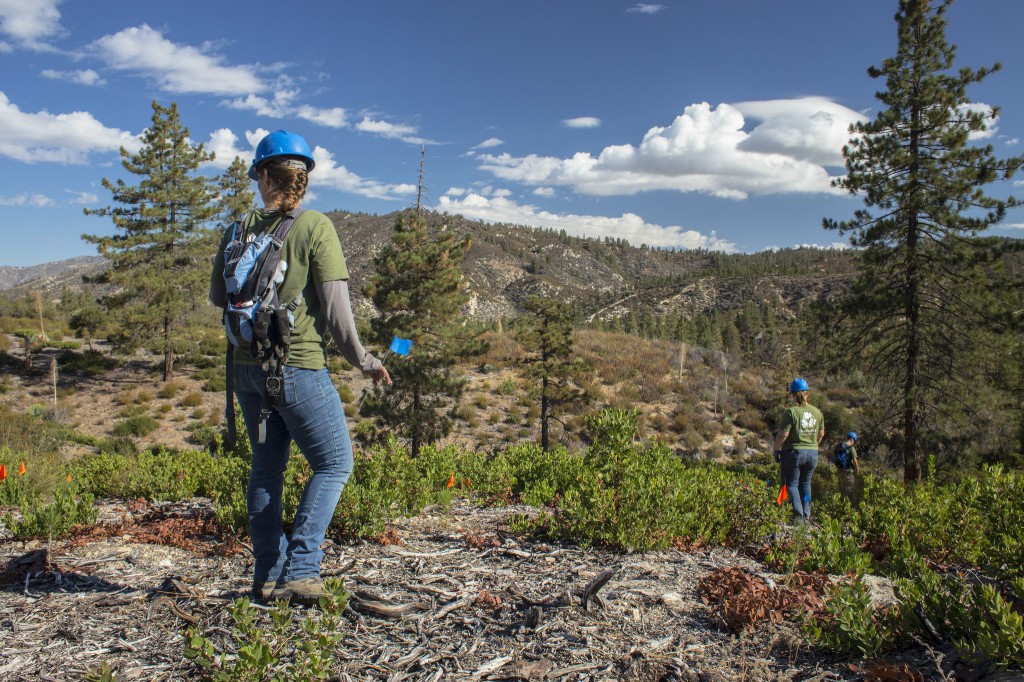At 18 events throughout the spring of 2013, more than a thousand volunteers planted nearly 10,000 seedlings in the Angeles National Forest, all around the Chilao campground.
It was all part of the ForestAid: Angeles program, a joint effort of the Forest Service and TreePeople to lead reforestation efforts after the 2009 Station Fire that burned down 400 acres of forest.
After the trees were planted, we worked through the summer to care for these young trees and help them get through a very hot and long summer. But unfortunately, last year’s drought has continued into this year, with record low precipitation across the entire state.
So back in February, after carefully examining the soil conditions, the Forest Service and TreePeople had to cancel this year’s planting season – bad news for all campers, hikers, nature lovers and everyone else who likes the mountains and forest and would like to see them come back to their full potential sooner rather than later. Bad news also for all Angelenos, as helping regenerate the forest is an integral part of restoring the city’s watershed. In a time when water is even sparser than before, we want trees to capture whatever little rain falls, whether in their canopies or in their root zones, so that they eventually send it back to the aquifer.
When we found out we would not be able to plant this year, we started to look at doing more tree care to try and boost the survival rate from the 2013 plantings. But the further bad news was that the Forest Service had depleted water reserves in the Angeles, preventing us from using water to care for the trees. So we found ourselves with not many options and a serious concern that our reforestation efforts had come to a halt.
We took this time as an opportunity to survey the planted areas. After being baked in the sun for so many days, weeks and months, some of the seedlings had given up. Coulter Pines – one species we’d planted in Chilao – have a great capacity to adapt to drought. They can live in rocky, sandy soil with barely any moisture around. But while that is true of a mature tree, saplings have a much harder time getting through dry and hot weather. Understandably, their roots, bark and needles have not reached the size and strength they need to deal with the extreme conditions that older Coulter Pines don’t seem to mind.
On the other hand, many trees were still alive, though some were obviously stressed and struggling. Something had to be done to help them get through another hot and dry year.
We looked at many options and, eventually, felt some moisture coming our way. After meeting several water agencies from the LA area, the City of Burbank Water & Power came through and offered to donate some of its recycled water—which is non-potable but fine for trees1—to ForestAid. Then NorthEast Valley ranch owner Dale Gibson offered a couple of big water tanks to help us haul the water up the Angeles Crest Highway. And everything fell into place.
On August 23rd and 24th, ForestAid came back to life! Some of our most dedicated Volunteer Supervisors came to Chilao. They put their blue hard hats on, unrolled the hoses down the hill, and grabbed some hand tools and buckets. The plan was to create berms around the seedlings, collect local mulch and spread it around the base of the tree, and then of course, add water.
In two mornings, we were able to care for 125 trees. All of these were on the Southern slope, the one most hit by the sun, where our survival rate was the lowest. And after two days of hard work, everyone had smiles on their faces. We now feel confident that our efforts won’t be in vain. The young trees that are alive will stay alive and grow…that is: they will if you come help us too!
On September 14 and 21, we will be in Chilao again with another load of water. If you come give us a hand, we can care for all of the seedlings that need help.
And from the ashes and the dust, a new forest will rise.
1. We watered the trees with Title 22 recycled water, which is not proper for human consumption—primarily because recycled water has a higher level of salt than potable water. Our tanks and hoses were labeled “non-potable water” or “do not drink” and were colored purple, and TreePeople personnel were trained how to properly use recycled water and how to inform our volunteers. While the restrictions are in place to protect the public, research shows that our young trees will be very happy to have their thirst quenched and won’t mind the minimal extra salt—and it’s a great way to maximize our water use.

